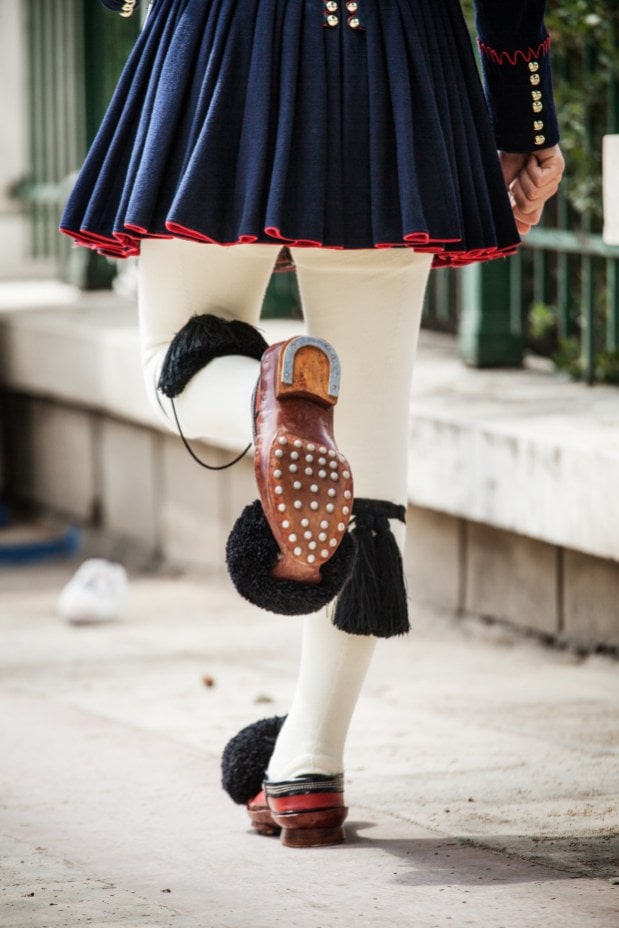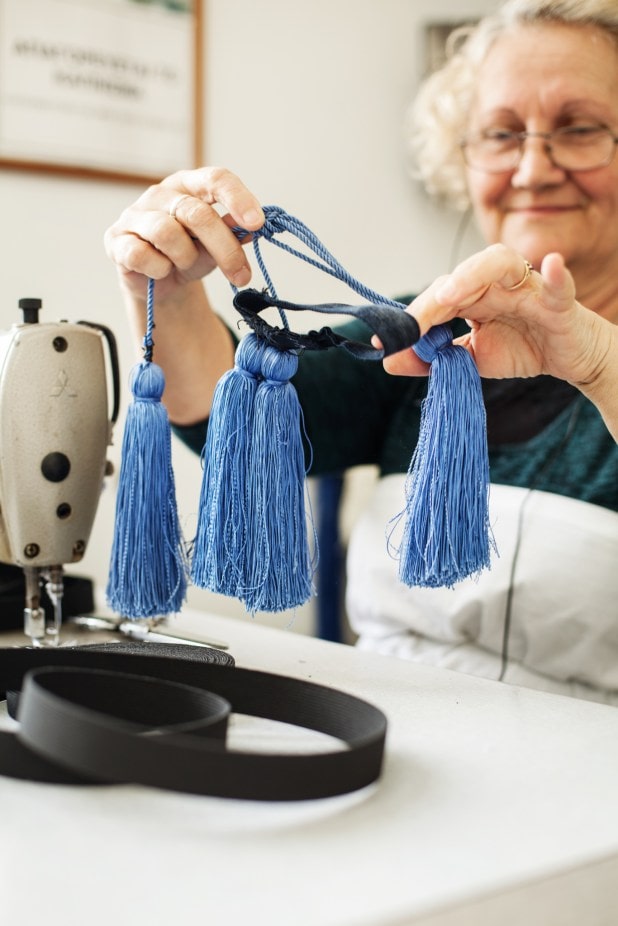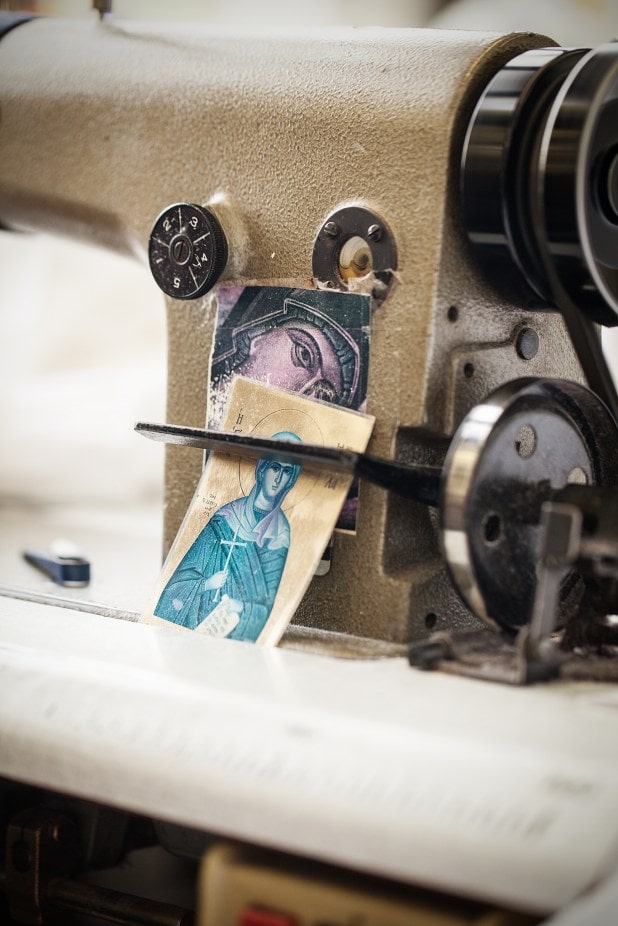Stories About Craftsmanship in Greece
For centuries craftsmanship, the predecessor of industry, has shaped culture and everyday life. Crafted products show region-specific, social, political and economic conditions as well as cultural and religious characteristics. During several trips cultural worker and artist curator Laura Bernhardt, and photographer Benjamin Tafel have undertaken a search for traces of the still active craft workshops in Greece. In dialogue with a selection of protagonists the project examines their situation, their emotional relationship with their profession and their prospects. The result is a series of portraits that show the artisan in relation to his or her profession and the current situation of upheaval.

Trained artisans make the uniforms by hand in special workshops following traditional patterns.
From Hand-to-Hand meticulous storytelling: The Evzones’ Uniform – A Ceremonial Costume
The effort and level of detail behind the ceremony is hardly visible for outsiders. Trained artisans and soldiers make the uniforms by hand in special workshops following traditional patterns. At the entrance in Irodu Attikou Street we are warmly received by Michael Maravgakis, a lieutenant of the guard, and requested to leave our ID cards. The workshops are located in the Evzones’ training camp, on the grounds of the parliament building. We cross a courtyard where the next shift is preparing for their performance. Highly concentrated, the elite regiment exercises each move in every detail. It is a great honour to be admitted to the training to become an Evzone. The soldier has to be at least 1,87 m tall, well-toned and persistent when starting the one-month training during his military service. The most important discipline is remaining completely stationary for one hour.


One shoe weighs around 1,5 kilos.
Since they are used on a daily basis, the soles of the tsarouchia have to be fitted with new nails every week.
The “well-belted”, the literal translation of Evzone, have a long tradition in the history of Greece. The soldiers of the elite regiment are swinging their legs upwards in a 45° angle and stride solemnly in pairs in an elaborate choreography. On Sundays and special occasions the Evzones wear foustanella, a white pleated skirt, ypodete, a white shirt with wide sleeves and an elaborately embroidered waistcoat, the fermeli. On the other days they wear a simple uniform with a skirt, khaki during summer, navy blue during winter. To complete the outfit the guards wear red tsarouchia, traditional poulaines, and a red felt cap with a long black silk tassel. The present-day uniform dates back to King Otto around 1868 and was allegedly designed by Queen Amalia. According to a Greek legend, the 400 pleats of the foustanella represent each year of Ottoman rule.
In the workshops of the Presidential Guard
In the leather workshop located in the basement we are welcomed by a tall athletic sergeant major. Wearing a camouflage shirt and a khaki-coloured apron he sits at a long workbench, nailing thick layers of leather over a shoe last. Tsarouchia, the traditional red clogs with a black woollen pompom are made of multiple layers of thick ox leather that are sown and nailed together. One shoe weighs around 1,5 kilos. Since they are used on a daily basis, the soles of the tsarouchia have to be fitted with new nails every week.

Tsarouchia, the traditional red clogs with a black woollen pompom are made of multiple layers of thick ox leather that are sown and nailed together.
Foustanella, a pleated skirt made of 800 pieces
The sewing workshop, a big and luminous room with a view of the parade ground is located on the second floor. A team of seamstresses and soldiers under the direction of a master tailor is working here. On their sewing machines the women sew together the 800 voluminous fabric pieces to create the foustanella. Two slim triangles become one pleat. In the corner on the opposite side three soldiers are mending the waistbands of their foustanella.


The ornaments have historical references and are different according to the rank of the Evzones.
On their sewing machines the women sew together the 800 voluminous fabric pieces to create the foustanella.
The master tailor shows us a finished fermeli. 6 months of work, he explains, to embroider the waistcoat, the showpiece of the uniform. The ornaments have historical references and are different according to the rank of the Evzones. The stiffened foustanella, protected by plastic covers, are stacked on the tables. Lieutenant Maravgakis takes up a farion, glides with his fingers through the silk tassel and says:
“after each changing of the guard the Evzone has to untangle the tassel. That can take a lot of time!”


Participating in the creation of the uniform, dressing, and particularly its care, such as the ironing and stiffening of the foustanella’s 400 pleats are important tasks of the Evzones.
The sewing workshop, is a big and luminous room with a view of the parade ground
Participating in the creation of the uniform, dressing, and particularly its care, such as the ironing and stiffening of the foustanella’s 400 pleats are important tasks of the Evzones. They are regarded as part of the training and the ceremony. Evzones work their shifts in teams of two. The team doesn’t change for the entire period of training and service. From its creation to the ceremonies, the national symbol is cultivated
Credits
Words
Laura Bernhardt
Images
Benjamin Tafel
From Hand-to-Hand
The project was supported by grant funding from The Stiftung Kulturwerk cultural foundation.

Tell us what you think...